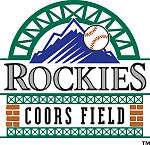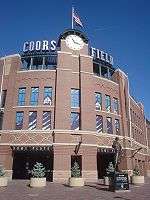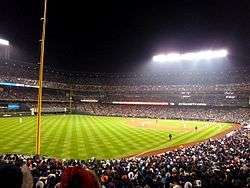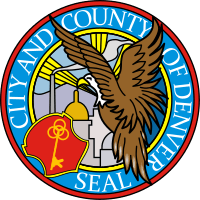Coors Field
 | |
 | |
| Address | 2001 Blake Street |
|---|---|
| Location | Denver, Colorado |
| Coordinates | 39°45′22″N 104°59′39″W / 39.75611°N 104.99417°WCoordinates: 39°45′22″N 104°59′39″W / 39.75611°N 104.99417°W |
| Public transit | Denver Union Station |
| Owner | Denver Metropolitan Major League Baseball Stadium District |
| Operator | Colorado Rockies Baseball Club Ltd.[1] |
| Capacity |
50,398 (2012–present)[2] 50,490 (2011) 50,445 (2001–2010) 50,381 (1999–2000) 50,200 (1995–1998) |
| Record attendance | 51,267 |
| Field size |
Left Field – 347 feet (106 m) Left-Center – 390 feet (119 m) Center Field – 415 feet (126 m) Right-Center – 375 feet (114 m) Right Field – 350 feet (107 m) Backstop – 56 feet (17 m) |
| Surface | Kentucky Bluegrass/Perennial Ryegrass |
| Construction | |
| Broke ground | October 16, 1992 |
| Opened | April 26, 1995[3] |
| Construction cost |
US$300 million ($467 million in 2016 dollars[4]) |
| Architect | HOK Sport (now Populous) |
| Project manager | CMTS, Inc.[5] |
| Structural engineer | Martin/Martin, Inc.[6] |
| Services engineer | M-E Engineers, Inc.[7] |
| General contractor | Mortenson/Barton Malow[6] |
| Main contractors |
LPR Construction[8] Havens Steel[6] Zimmerman Metals[6] Zimkor Industries[6] LPR Erectors[6] |
| Tenants | |
| Colorado Rockies (MLB) (1995–present) | |
Coors Field is a baseball park located in downtown Denver, Colorado. It is the home field of the Colorado Rockies, the city's Major League Baseball (MLB) franchise. It is named for the Coors Brewing Company of Golden, Colorado, which purchased the naming rights to the park prior to its completion in 1995. The Rockies played their first two seasons, 1993 and 1994, in Mile High Stadium before moving to Coors Field, two blocks from Union Station in Denver's Lower Downtown (or LoDo) neighborhood. The park includes 63 luxury suites and 4,526 club seats.
Construction
Coors Field was the first new stadium added in a six-year period in which Denver's sports venues were upgraded, along with Pepsi Center and Sports Authority Field at Mile High (originally sponsored by INVESCO). It was also the first baseball-only park in the National League since Dodger Stadium was built in 1962.
As with the other new venues, Coors Field was constructed with accessibility in mind. It sits near Interstate 25 and has direct access to the 20th Street and Park Avenue exits. Nearby Union Station also provides light rail access.
Coors Field was originally planned to be somewhat smaller, seating only 43,800. However, after the Rockies drew almost 4.5 million people in their first season at Mile High Stadium – the most in baseball history – the plans were altered during construction, and new seats in the right field upper deck were added.
The center field bleacher section is named "The Rockpile". During the 1993 and 1994 seasons when the team played at Mile High Stadium, which was a hybrid football/baseball venue, the Rockpile was located next to the south stands, which were in dead center field and very distant from home plate. The same design was incorporated into Coors Field, and is located in deep center field up high. The original Rockpile seats cost a dollar each.
During construction, workers discovered a number of dinosaur fossils throughout the grounds, including a 7-foot-long (2.1 m) 1,000-pound (450 kg) triceratops skull. Because of this, "Jurassic Park" was one of the first names to be considered for the stadium. This later led to the selection of a triceratops as the Rockies' mascot, Dinger.[9]
Coors Field was the first major league park with an underground heating system.
Features

While most of the seats in Coors Field are dark green, the seats in the 20th row of the upper deck are purple to mark the elevation of one mile (1,609 m) above sea level.

The Blue Moon Brewery at The Sandlot is a microbrewery/restaurant that is behind the Right Field Stands, with an entrance from Coors Field, and from Blake Street. The brewery is operated by the Coors Brewing Company, and experiments with craft beers on a small scale. The Brewery has won multiple awards at the Great American Beer Festival in various categories. The popular Blue Moon, a Belgian-Style Wheat beer was invented here, and is now mass-produced by Coors. The restaurant is housed in a building that is attached to the stadium. Coors Field has an extensive selection of food items. Selections include Rockie dogs, Denver dogs, vegetarian dogs and burgers, and all of the usual ball park items.
Behind the center field wall is a landscape decoration that reflects the typical environment of the Rocky Mountains. This landscape area consists of a waterfall, fountains, and pine trees. After a Rockies home run or win, the fountains shoot high into the air.
The park has two large light emitting diode (LED) video displays and one ribbon display in the outfield from Daktronics. The top display, underneath the "Rockies" logo, measures 27 by 47 feet (8 m × 14 m). The second display measure 33 by 73 feet (10 m × 22 m) and is used to give lineups and statistics and as a scoreboard. The field also contains several Daktronics ribbon displays, totaling approximately 833 feet (254 m) in length.[10]
After the close of the 2013 season, renovations began on the right field portion of the upper deck, converted into an outdoor party deck for 2014.[11]
Reputation as a home run-friendly park
Stadium designers speculated early on that Coors Field would give up a lot of home runs. At 5,200 feet (1,580 m) above sea level, it is by far the highest park in the majors (Chase Field in Phoenix is next at 1,100 feet (340 m)), and designers knew that the low air density at such a high elevation would result in balls traveling farther than in other parks. To compensate, the outfield fences were placed at an unusually far distance from home plate, thus creating the largest outfield in Major League Baseball today, according to Business Insider.[12] In spite of the pushed-back fences, for many years Coors Field not only gave up the most home runs in baseball, but due to the resultant large field area, the most doubles and triples as well.[13]
In its first decade, the above-average number of home runs earned Coors Field a reputation as the most hitter-friendly park in Major League Baseball, earning the critical nicknames "Coors Canaveral"[14] (a reference to Cape Canaveral, from where NASA launches spacecraft) and "Williamsport" (referring to the site of the Little League World Series, which has been traditionally dominated by batters). Prior to the 2002 baseball season, studies determined that it was more the dry air rather than thin air which contributed to the more frequent home runs. It was found that baseballs stored in drier air are harder and therefore more elastic to the impact of the bat. A room-sized humidor was installed in which to store the baseballs, and since its introduction the number of home runs at Coors Field has decreased and is now nearly the same as other parks.[15]
Regardless of ball humidity, elevation is still a factor to the game. The ball does slip more easily through the thin air allowing for longer hits. In addition, the curveball tends to curve less with the thin air than at sea level leading to fewer strikeouts and fewer effective pitches for pitchers to work with.[16]
Coors Field twice broke the major league record for home runs hit in a ballpark in one season. The previous record, 248, had been set at the Angels' original home of Wrigley Field in Los Angeles in 1961, its only year for major league ball. In Coors Field's first year, the home run total fell just 7 short of that mark, despite losing 9 games from the home schedule (or 1/9 of the normal 81) due to the strike that had continued from 1994. The next season, 1996, with a full schedule finally, 271 home runs were hit at Coors Field. In 1999, the current major league record was set at 303. The annual home run figure dropped noticeably in 2002, and has dropped below 200 starting in 2005.[17]
Although the number of home runs hit per season at Coors Field is decreasing, Coors Field still remains the most hitter friendly ballpark in the Major Leagues by a wide margin. From 2012–2015 the Colorado Rockies led the league in runs scored in home games, while being last in the league for runs scored in away games. This demonstrates the extreme benefit that Coors Field's low air density provides to hitters.[18]

Notable events
The 1998 Major League Baseball All-Star Game took place in Coors Field.
On July 2, 2003, a three-flight escalator malfunctioned, injuring 30 people. One woman, Peggy Nance, eventually would have to have her leg amputated. Overcrowding and a malfunctioning wire were blamed. The Rockies never admitted to any responsibility.
In 2011, a man fell to his death when he was attempting to slide down a stair railing during the 7th inning of a Rockies-Diamondbacks game.[19]
On April 23, 2013, Rockies and Braves played in the coldest game since MLB began tracking game time temperature in 1991, at 23 °F (−5 °C).[20]
There have been nine 1-0 games in Coors Field history, through the 2015 season. The first 1-0 game at Coors Field was on July 9, 2005,[21] meaning all nine games have occurred since Major League Baseball allowed the Rockies to start using a humidor on May 15, 2002:[22]

- July 9, 2005, Rockies beat the San Diego Padres[21]
- April 16, 2006, Philadelphia Phillies beat the Rockies[23]
- July 25, 2006, St. Louis Cardinals beat the Rockies[24]
- August 1, 2006, Milwaukee Brewers beat the Rockies[25]
- June 11, 2008, Rockies beat the San Francisco Giants[26]
- September 14, 2008, Rockies beat the Los Angeles Dodgers in 10 innings[27][28]
- September 17, 2008, Rockies beat the San Diego Padres[29]
- July 6, 2009, Rockies beat the Washington Nationals[30]
- June 12, 2010, Rockies beat the Toronto Blue Jays[31]
Games 3 and 4 of the 2007 World Series between the Rockies and the Boston Red Sox were held at Coors Field. The Red Sox swept both games to win the title.
On August 7, 2016, Ichiro Suzuki collected his 3,000th MLB career hit; a seventh inning triple off Rockies pitcher Chris Rusin.
On July 3, 2015, the Zac Brown Band played the first major concert at the ballpark in front of 42,000 fans.
Coors Field also hosted two outdoor ice hockey games in February 2016. First, on February 20, the local Denver Pioneers defeated their arch-rival Colorado College 4-1[32] in a college match billed as the "Battle on Blake".[33] Then, one week later on February 27, the Colorado Avalanche lost to the Detroit Red Wings 5-3[32] as part of the 2016 NHL Stadium Series.[34][35]
The "Voice" of Coors Field
Alan Roach was the main PA announcer since Coors Field opened in 1995. In the spring preceding the 2007 Rockies season, Roach announced his retirement from his post at Coors Field to spend more time over the summer with his family. He did come back to substitute in 2008. Roach is also the PA announcer for the nearby Colorado Avalanche hockey team of the NHL and former PA announcer for the Denver Broncos of the NFL. He also provides voice-overs for local sports introductions in the region, in addition to hosting a local sports talk radio show. He is currently the PA Announcer for the Minnesota Vikings of the NFL. He is also one of the voices of the train system at Denver International Airport, and has also been heard as the PA announcer at recent Super Bowls. Reed Saunders, 23, was chosen to be the new voice of Coors Field on March 16, 2007.
In popular culture
Coors Field was featured in the movie The Fan (1996) featuring Robert De Niro and Wesley Snipes. The ballpark was also featured in two episodes of South Park: "Professor Chaos" and "The Losing Edge", respectively.
Coors Field firsts
From Inaugural Game, April 26, 1995 (Colorado 11, New York Mets 9, 14 innings):
- First Official Game and First Extra Inning Game
- First National Anthem: Colorado Children's Chorale
- First Pitch: 5:38 p.m., Bill Swift to Brett Butler
- First First Plate Appearance, First At Bat,First Swing and First Hit: Brett Butler, infield single, 1st inning
- First Batter to Ground Into Double Play: José Vizcaíno (Mets), turned 6-3, Walt Weiss to Andrés Galarraga
- First Putout: Walt Weiss put out Brett Butler at second base (during the double play mentioned above)
- First Extra-Base Hit and First Run Batted In: Larry Walker (Rockies) double in 1st inning
- First Run: Walt Weiss (Rockies), 1st inning
- First Flyout and First Sacrifice Fly: Dante Bichette (Rockies), putout by David Segui, scoring Joe Girardi, 1st inning
- First Person to spit in the bullpen Jerry DiPoto chewing tobacco
- First Strikeout: Bill Swift, struck out (called) David Segui, 2nd inning
- First Sacrifice Bunt: Bobby Jones (Mets), 3rd inning
- First Home Run: Rico Brogna (Mets), 4th inning off Swift
- First Base On Balls: Bobby Jones (Mets) walked Bill Swift, 5th inning
- First Grand Slam: Todd Hundley (Mets), 6th inning off Swift
- First Pinch Hitter: John Vander Wal announced for Swift (did not appear), Eric Young pinched for Vander Wal, 6th inning
- First Relief Pitcher: Jerry DiPoto (Mets), 6th inning
- First Batter to be Hit By Pitch: Roberto Mejía (Rockies) by DiPoto, 6th inning
- First Right Field Outfield Assist: Carl Everett (Mets), Vinny Castilla at second base, 6th inning
- First Wild Pitch: Mike Munoz (Rockies), facing Rico Brogna, 7th inning
- First Blown Save: Mike Munoz (Rockies), 7th inning; the Mets John Franco and Mike Remlinger recorded the second and third blown saves in Coors Field history in the 9th and 14th innings of this same inaugural game, respectively
- First Pinch Runner: Brook Fordyce (Mets), 8th inning
- First Foul Popfly: Andrés Galarraga (Rockies), fielded by Jeff Kent
- First Left Field Outfield Assist: Dante Bichette (Rockies), José Vizcaíno at second base, 13th inning
- Intentional Base On Balls: Todd Hundley (Mets), by pitcher Mark Thompson
- First Pinch Base Hit: Jim Tatum (Rockies), 13th inning
- First Error: Tim Bogar (Mets), 14th inning
- First Walk-Off Home Run (and First Rockies Home Run): Dante Bichette (Rockies), three-run home run, 14th inning
Later Firsts:
- First Stolen Base: April 27, 1995, Eric Young and Walt Weiss (Rockies) double steal
- First Passed Ball: April 27, 1995, Joe Girardi (Rockies)
- First Triple: April 27, 1995, Andrés Galarraga (Rockies)
- First Baserunner Caught Stealing: April 27, 1995, Carl Everett (Mets), by A.J. Sager / Joe Girardi
- First Back to Back Home Runs: May 6, 1995, Mike Kingery and Roberto Mejía (Rockies)
- First Center Field Outfield Assist: May 6, 1995, Raúl Mondesí (Los Angeles Dodgers), Larry Walker at second base
- First Baserunner Picked Off Caught Stealing: May 11, 1995, Dante Bichette (Rockies) at third base, by Terry Mulholland (San Francisco Giants)
- First Baserunner Picked Off On Base: June 6, 1995, Brian Jordan (St. Louis Cardinals), by Mark Thompson at 1st base
- First Balk: Marvin Freeman (Rockies), June 7, 1995
- First Complete Game and First Shutout (and, of course, the first Complete Game Shutout): June 16, 1995, Tom Glavine (Atlanta Braves)
- First Hitting for the Cycle: May 18, 1996, John Mabry (St. Louis Cardinals); 11th natural cycle in MLB history
- First No-hitter: September 17, 1996, Hideo Nomo (Los Angeles Dodgers);
- Unassisted Triple Play: April 29, 2007, Troy Tulowitzki (Rockies)
References
- ↑ "Sports Business Resource Guide & Fact Book" (PDF). Street's and Smith's. 2006. Archived from the original (PDF) on 2012-09-10. Retrieved September 21, 2011.
- ↑ Groke, Nick (April 2, 2014). "Rockies' Rooftop party deck at Coors Field "another dimension", Dick Monfort says". The Denver Post. Retrieved February 9, 2016.
- ↑ http://www.worldofstadiums.com/north-america/united-states/colorado/coors-field/
- ↑ Federal Reserve Bank of Minneapolis Community Development Project. "Consumer Price Index (estimate) 1800–". Federal Reserve Bank of Minneapolis. Retrieved October 21, 2016.
- ↑ "Coors Field – Denver, Colorado". CMTS, Inc. Retrieved October 12, 2011.
- 1 2 3 4 5 6 "Coors Field Baseball Stadium" (PDF). Modern Steel Construction. April 1998. Retrieved September 21, 2011.
- ↑ "Colorado Rockies Ballpark – Denver, Colorado". M-E Engineers, Inc. Retrieved September 21, 2011.
- ↑ "Coors Field". LPR Construction. Retrieved March 16, 2013.
- ↑ Dinger, Colorado Rockies mascot
- ↑ "Colorado Rockies, Coors Field". Daktronics. Retrieved March 16, 2013.
- ↑ "Rooftop Deck". Major League Baseball Advanced Media. Retrieved April 4, 2014.
- ↑ "CHART: MLB Ballpark Sizes Show the Immense Difference Between Fenway Park and Coors Field". Business Insider. Retrieved April 24, 2016.
- ↑ Lowry, Phillip (2005). Green Cathedrals. New York City: Walker & Company. ISBN 0-8027-1562-1.
- ↑ Armstrong, Jim (June 13, 1999). "Opening Shots". The Denver Post. Retrieved June 5, 2012.
- ↑ Renck, Troy E. (June 21, 2006). "More Humidors Likely on Horizon". The Denver Post. Retrieved June 12, 2007.
- ↑ Kalk, Josh (June 17, 2008). "What to pack for Denver". Hardball Times. Retrieved March 16, 2013.
- ↑ "Coors Field in Denver, Colorado". Retrosheet. Retrieved March 16, 2013.
- ↑ "How do Ballpark Factors Affect Batters for MLB DFS? (part 1) – DFS STRATEGY". DFS STRATEGY. 2016-03-24. Retrieved 2016-05-09.
- ↑ Henry, Ray (September 1, 2012). "Police: Fan, 20, Was Drinking Before Ga. Dome Fall". Yahoo! Sports. Associated Press. Retrieved March 16, 2013.
- ↑ "Atlanta Braves vs. Colorado Rockies - Recap - April 23, 2013 - ESPN". ESPN. Associated Press. "April 23, 2012". Retrieved April 23, 2013. Check date values in:
|date=(help) - 1 2 "Padres vs. Rockies Recap". ESPN. Associated Press. July 9, 2006. Retrieved July 9, 2006.
- ↑ Bodley, Hal (May 14, 2002). "Baseball Gives Rockies' Humidor Its OK". USA Today. Retrieved March 16, 2013.
- ↑ "Phillies vs. Rockies – Recap". ESPN. Associated Press. April 16, 2006. Retrieved April 16, 2006.
- ↑ "Cardinals vs. Rockies – Recap". ESPN. Associated Press. July 25, 2006. Retrieved July 25, 2006.
- ↑ "Brewers vs. Rockies – Recap". ESPN. Associated Press. August 1, 2006. Retrieved August 1, 2006.
- ↑ "Giants vs. Rockies – Recap". ESPN. Associated Press. June 11, 2008. Retrieved June 11, 2008.
- ↑ Only scoreless game through nine innings at Coors Field.
- ↑ "Dodgers vs. Rockies – Recap". ESPN. Associated Press. September 14, 2008. Retrieved September 14, 2008.
- ↑ "Padres vs. Rockies – Recap". ESPN. Associated Press. September 17, 2008. Retrieved September 17, 2008.
- ↑ "Nationals vs. Rockies – Recap". ESPN. Associated Press. July 6, 2009. Retrieved July 6, 2009.
- ↑ "Blue Jays vs. Rockies – Recap". ESPN. Associated Press. June 12, 2010. Retrieved June 12, 2010.
- 1 2 http://www.denverpost.com/colleges/ci_29542580/denver-hockey-gets-by-colorado-college-big-crowd
- ↑ "Game Time, On-Sale Date for the 'Battle on Blake' Announced" (Press release). Denver Pioneers. September 14, 2015. Retrieved September 22, 2015.
- ↑ Dater, Adrian (January 2, 2011). "Odds of Denver Hosting the Next Winter Classic". The Denver Post. Retrieved March 16, 2013.
- ↑ "NHL announces 2016 Winter Classic, Stadium Series". NHL.com. NHL.com. January 24, 2015. Retrieved January 24, 2015.
External links
| Wikimedia Commons has media related to Coors Field. |
- Stadium site on coloradorockies.com
- Ballpark Digest visit to Coors Field
- Ballparks of Baseball
- Coors Field images and information
- Aerial photo of Coors Field from USGS via Microsoft Research Maps
| Events and tenants | ||
|---|---|---|
| Preceded by Mile High Stadium |
Home of the Colorado Rockies 1995 – present |
Succeeded by Current |
| Preceded by Jacobs Field |
Host of the All-Star Game 1998 |
Succeeded by Fenway Park |

